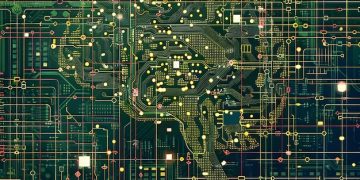US Cybersecurity Policy: Protecting American Interests in the Digital Age

US Cybersecurity Policy: Protecting American Interests in the Digital Age encompasses a multifaceted strategy involving legislation, international cooperation, and technological innovation to safeguard critical infrastructure, data, and intellectual property from cyber threats.
In an increasingly interconnected world, the **US Cybersecurity Policy: Protecting American Interests in the Digital Age** stands as a crucial framework for safeguarding the nation’s digital assets and infrastructure. Understanding its intricacies is vital for navigating the complex landscape of cyber threats.
Understanding the Foundations of US Cybersecurity Policy
The US Cybersecurity Policy is built upon a complex foundation of laws, regulations, and executive orders. These elements work together to create a comprehensive framework for protecting American interests in the digital realm.
Understanding these foundational elements is key to grasping the overall strategy.
Key Legislation Shaping Cybersecurity
Several pieces of legislation have played a pivotal role in shaping US cybersecurity policy.
- The Computer Fraud and Abuse Act (CFAA): This act, enacted in 1986, was one of the first federal laws addressing computer hacking and fraud. It has been amended over the years to keep pace with evolving cyber threats.
- The Cybersecurity Information Sharing Act (CISA): CISA encourages the sharing of cyber threat information between the government and private sector companies, aiming to enhance collective defense against cyberattacks.
- The National Institute of Standards and Technology (NIST) Cybersecurity Framework: While not a law itself, the NIST framework provides a voluntary set of standards, guidelines, and best practices to help organizations manage and reduce cybersecurity risks.
These legislative efforts demonstrate the ongoing commitment to addressing cybersecurity challenges.

Executive Orders and Cybersecurity
Executive orders have also been instrumental in shaping US cybersecurity policy.
For example, Executive Order 13636, “Improving Critical Infrastructure Cybersecurity,” directed the development of the NIST Cybersecurity Framework.
More recently, Executive Order 14028, “Improving the Nation’s Cybersecurity,” aims to enhance supply chain security and improve incident response capabilities across federal agencies.
Executive orders provide a flexible and rapid means of addressing emerging cybersecurity threats and priorities.
In conclusion, the foundations of US Cybersecurity Policy are multifaceted, involving legislative acts and executive actions to establish a robust defense against digital threats.
Critical Infrastructure Protection
Protecting critical infrastructure is a cornerstone of US cybersecurity policy. This involves securing essential assets and systems that are vital to the nation’s security, economy, and public health.
The interconnected nature of these systems makes them vulnerable to cyberattacks.
Defining Critical Infrastructure
Critical infrastructure includes sectors such as:
- Energy
- Water
- Transportation
- Financial Services
These sectors are highly interdependent, and a successful cyberattack on one sector can have cascading effects on others.
Challenges in Securing Critical Infrastructure
Securing critical infrastructure presents unique challenges.
Many systems were not originally designed with cybersecurity in mind, making them vulnerable to modern threats.
Additionally, the increasing use of internet-connected devices in industrial control systems (ICS) and operational technology (OT) expands the attack surface.
Addressing these challenges requires a multi-layered approach that combines technology, policy, and collaboration.
Cyber threats can be devastating, and security requires collaboration and consistent upgrades.

Government Initiatives for Critical Infrastructure Cybersecurity
The US government has launched several initiatives to bolster critical infrastructure cybersecurity, including:
- The Cybersecurity and Infrastructure Security Agency (CISA): CISA serves as the lead federal agency for cybersecurity and infrastructure security, working with public and private sector partners to protect critical infrastructure.
- The Industrial Control Systems Cyber Emergency Response Team (ICS-CERT): ICS-CERT provides incident response support and technical assistance to organizations that operate ICS and OT systems.
- Information Sharing and Analysis Centers (ISACs): ISACs are sector-specific organizations that facilitate the sharing of cyber threat information among critical infrastructure owners and operators.
These initiatives aim to improve situational awareness, enhance incident response capabilities, and foster collaboration across sectors.
In summary, protecting critical infrastructure requires a comprehensive strategy that addresses the unique challenges and leverages government and private sector resources.
International Cooperation in Cybersecurity
Cybersecurity is a global challenge that requires international cooperation. Cyber threats often originate from outside US borders, necessitating collaboration with international partners to effectively address them.
Establishing strong international partnerships is crucial for deterring and responding to cyberattacks.
Key Areas of International Cooperation
International cooperation in cybersecurity encompasses several key areas:
- Information Sharing: Sharing cyber threat information with international partners can help organizations around the world better understand and mitigate risks.
- Capacity Building: Assisting other countries in developing their cybersecurity capabilities can strengthen the global cybersecurity ecosystem.
- Law Enforcement Cooperation: Working with international law enforcement agencies to investigate and prosecute cybercriminals can help deter malicious activity.
These collaborative efforts enhance overall cybersecurity resilience.
Challenges in International Cybersecurity Cooperation
- Differing legal and regulatory frameworks
- Geopolitical tensions
- Varied levels of cybersecurity maturity among nations
US Efforts to Foster International Cooperation
The US government actively engages in international cybersecurity cooperation.
The US Department of State leads diplomatic efforts on cybersecurity, working with international organizations and partner countries to promote responsible state behavior in cyberspace.
The US also participates in multilateral initiatives such as the Budapest Convention on Cybercrime, which provides a framework for international cooperation on cybercrime investigations.
In conclusion, international cooperation is vital for addressing the global cybersecurity challenge, and the US actively works to foster collaboration with international partners.
Addressing Cybercrime and Cyber Espionage
Cybercrime and cyber espionage pose significant threats to US national security and economic competitiveness. These malicious activities can result in financial losses, intellectual property theft, and damage to critical infrastructure.
Combating cybercrime and cyber espionage requires a multi-faceted approach that combines law enforcement, intelligence, and cybersecurity measures.
The Scope of Cybercrime and Cyber Espionage
Cybercrime encompasses a wide range of illegal activities conducted online, including:
- Fraud
- Identity theft
- Ransomware attacks
Cyber espionage involves the use of cyber capabilities to steal sensitive information from governments, companies, and individuals.
Challenges in Investigating and Prosecuting Cybercrimes
Investigating and prosecuting cybercrimes presents several challenges.
Cybercriminals often operate across borders, making it difficult to identify and apprehend them.
Additionally, cybercrime investigations require specialized technical expertise and can be time-consuming and resource-intensive.
Overcoming these challenges requires close collaboration between law enforcement agencies, intelligence communities, and private sector companies.
Addressing these issues head on is critical and benefits us all.
US Government Efforts to Combat Cybercrime and Cyber Espionage
The US government has implemented several strategies to combat cybercrime and cyber espionage, including:
- The Department of Justice (DOJ): The DOJ prosecutes cybercriminals and works with international partners to extradite offenders to the US.
- The Federal Bureau of Investigation (FBI): The FBI investigates cybercrimes and works to disrupt cybercriminal networks.
- US Cyber Command: US Cyber Command conducts offensive and defensive cyber operations to protect US interests in cyberspace.
These efforts aim to deter cybercrime and cyber espionage and hold perpetrators accountable for their actions.
The Role of Artificial Intelligence in Cybersecurity
Artificial intelligence (AI) is playing an increasingly important role in cybersecurity. AI technologies can be used to automate threat detection, improve incident response, and enhance overall cybersecurity resilience.
However, AI can also be used by cybercriminals to launch more sophisticated attacks.
Applications of AI in Cybersecurity
AI enables automated threat detection. AI algorithms can analyze large volumes of data to identify patterns and anomalies that may indicate a cyberattack.
AI can also improve incident response by automating tasks such as malware analysis and forensic investigation.
Additionally, AI can enhance overall cybersecurity resilience by providing real-time threat intelligence and adaptive security controls.
Challenges and Risks Associated with AI in Cybersecurity
While AI offers many benefits, it also presents challenges and risks.
AI systems are vulnerable to adversarial attacks, where cybercriminals attempt to manipulate AI algorithms to evade detection.
Additionally, the use of AI in cybersecurity raises ethical concerns, such as the potential for bias and discrimination.
Addressing these challenges requires careful consideration and responsible development and deployment of AI technologies.
Future Directions for AI in Cybersecurity
The future of AI in cybersecurity holds great promise. As AI technologies continue to evolve, they will likely play an even greater role in protecting against cyber threats.
Future research and development efforts should focus on:
- Improving the robustness of AI systems against adversarial attacks
- Addressing ethical concerns related to AI
- Developing new and innovative applications of AI for cybersecurity
In conclusion, AI has the potential to revolutionize cybersecurity, but it is important to address the challenges and risks associated with its use.
Future Trends and Challenges in US Cybersecurity Policy
US cybersecurity policy must evolve to keep pace with emerging threats and technological advancements. Several key trends and challenges will shape the future of cybersecurity.
Adapting to these trends and challenges is critical for maintaining a strong cybersecurity posture.
Emerging Technologies and Cybersecurity
Emerging technologies such as:
- Cloud computing
- The Internet of Things (IoT)
- 5G
While these technologies offer many benefits, they also expand the attack surface and introduce new vulnerabilities.
The Evolving Threat Landscape
The cyber threat landscape is constantly evolving. Cybercriminals are becoming more sophisticated and are increasingly using advanced techniques such as AI and machine learning to launch attacks.
Additionally, nation-state actors are becoming more active in cyberspace, conducting espionage, sabotage, and influence operations.
Policy Recommendations for the Future
To address these challenges, US cybersecurity policy should focus on several key areas:
- Strengthening public-private partnerships
- Investing in cybersecurity research and development
- Enhancing cybersecurity education and training
These recommendations aim to improve situational awareness, enhance incident response capabilities, and foster a culture of cybersecurity across all sectors.
| Key Point | Brief Description |
|---|---|
| 🛡️ Critical Infrastructure | Protection of essential sectors like energy, water, and transportation. |
| 🤝 International Cooperation | Collaboration with global partners to combat cyber threats. |
| 🤖 AI in Cybersecurity | Using artificial intelligence for threat detection and response. |
| 📜 Key Legislation | Laws like CFAA and CISA shaping cybersecurity measures. |
FAQ
The NIST Cybersecurity Framework is a voluntary set of standards, guidelines, and best practices to help organizations manage and reduce cybersecurity risks. It is widely used across various sectors.
The Cybersecurity and Infrastructure Security Agency (CISA) serves as the lead federal agency for cybersecurity and infrastructure security, working with public and private sector partners to protect critical infrastructure.
Cyber threats often originate from outside US borders, necessitating collaboration with international partners to effectively address them. Cooperation includes information sharing and law enforcement efforts.
Cybercriminals often operate across borders, making it difficult to identify and apprehend them. Also, these investigations require specialized technical expertise and are time-consuming.
AI technologies can be used to automate threat detection, improve incident response, and enhance overall cybersecurity resilience. However, AI can also be used by cybercriminals.
Conclusion
In conclusion, the US Cybersecurity Policy is a dynamic and evolving framework designed to protect American interests in the digital age. By understanding the foundations of this policy, addressing critical infrastructure vulnerabilities, fostering international cooperation, and embracing emerging technologies, we can work together to create a more secure and resilient cyberspace for all.





